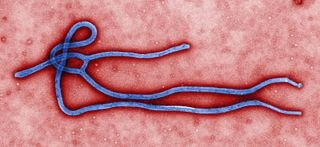People fear diseases such as Ebola, Marburg, Lassa fever, rabies and HIV for good reason; they have high mortality rates and few, if any, possible treatments. As many as 90 percent of people who contract Ebola, for instance, die of the disease.
Facing this gaping need for therapies, researchers at the University of Pennsylvania School of Veterinary Medicine teamed with colleagues to focus on identifying and developing compounds that could reduce a virus’ ability to spread infection. In two studies published in the Journal of Virology, the researchers have identified several prototypic compounds with the potential to one day serve as broad-spectrum anti-viral drugs.
Ronald N. Harty, an associate professor of microbiology at Penn Vet and senior author on both studies, collaborated with Penn Vet’s Jianhong Lu, Ziying Han, Yuliang Liu, Wenbo Liu, Gordon Ruthel and Bruce D. Freedman and two U.S. Army Medical Research Institute of Infectious Disease scientists, Michael S. Lee and Mark A. Olson, on both studies. On the second paper, the team was expanded to include Benjamin Davis and Matthias J. Schnell of Thomas Jefferson University and Jay E. Wrobel and Allen B. Reitz of Fox Chase Chemical Diversity Center.
Viruses, which cannot reproduce on their own, hijack host cell proteins and machinery in order to replicate. After doing so, many viruses exit the cell in a process called “budding” in order to infect other cells and spread.
“What happens is the virus actually hijacks or recruits different host proteins and host functions and makes use of those proteins to efficiently get out of the cell,” Harty said.
In the two new papers, Harty and colleagues zeroed in on this step in the budding process, attempting to block it and reduce the infection to a level a person’s immune system would be able to control more easily.
In the first paper, the researchers examined the interaction between the viral protein sequence known as PTAP, which is present in proteins that play important roles in the budding of Ebola and HIV, and the human protein Tsg101. This interplay is important for the virus to break free of the host cell’s plasma membrane and continue infecting other cells. If this interaction is blocked, many of the viruses will remain tethered to the cell membrane, unable to perpetuate the infection.
Though the viruses under study are too dangerous to manipulate in the Penn Vet lab, Harty’s team was nonetheless able to examine the interactions between host and viral proteins by looking at what are known as virus-like particles, or VLPs, produced using the virus’ matrix protein, of which PTAP is a part.
“If you take just the matrix protein, it can self-assemble and bud from cells on its own as a VLP,” Harty said. “Because that particle is composed only of the matrix protein and no genetic material, it’s not infectious. It’s a neat assay that we can use in our lab to learn more about the budding process.”
Using this assay, Harty’s team screened a library of various small molecules to find some that would block the interaction between PTAP and Tsg101. They found a promising candidate called compound 0013.
Testing the effectiveness of this molecule in their VLP assay, they found that it reduced the ability of the virus to bud off from human cells in culture by more than 90 percent and was similarly effective against proteins found in Ebola and HIV.
As a final confirmation of the compound’s potential to stop a virus from spreading, they tested it against an actual virus: the nonpathogenic vaccine strain of the Junin virus. The pathogenic strain of Junin virus causes Argentine hemorrhagic fever and is considered a potential bioterrorism agent. The researchers found that it significantly decreased viral budding in a dose-dependent manner.
The second paper used an analogous strategy to try to block another viral-host interaction, this time examining the viral protein sequence called PPxY, which is found in the matrix proteins of Marburg, Ebola and rabies viruses and a host of other dangerous pathogens. PPxY interacts with an enzyme in human cells called Nedd4 during budding.
Again, after screening many small molecules to see which would best inhibit the PPxY-Nedd4 interaction, the team found two strong candidate molecules. Further testing showed that they could effectively inhibit budding of rabies virus, Marburg VLPs and other PPxY-containing viruses, likely reducing the probability of an infection getting out of control.
“By slowing down virus budding, we may allow an individuals immune system a chance to develop a robust and a protective response,” Harty said.
Looking for drugs that target interactions between a virus and host, such as these proteins involved in budding, reduces the likelihood that a virus would mutate to develop resistance, which is an advantage of this strategy, Harty said.
“If they did that, the virus would be compromising its own ability to exit the cell and continue spreading infection,” he noted.
This focus on the host side also comes with a potential drawback, the possibility that a drug might compromise the normal function of the protein. Further refinement of the drugs could reduce this possibility, but, when dealing with severe diseases such as Ebola and Argentine hemorrhagic fever, the benefits of treating an otherwise fatal condition would outweigh potential side effects.
These drugs could also be offered in a cocktail with additional compounds that block other stages of the virus life cycle, further amplifying their power. The next steps for these potential antivirals will be to test them in animal models.
“The main reason we’re excited is that, if we can come up with something that’s effective, it could have a very broad spectrum appeal,” Harty said. “That would give us a great way to protect the military, government workers or first responders from these very dangerous diseases.”


